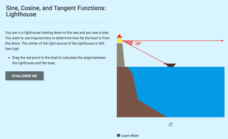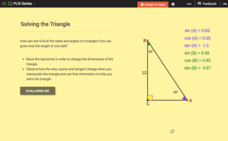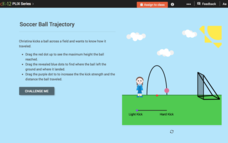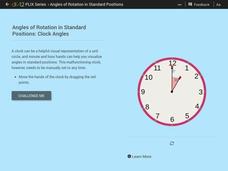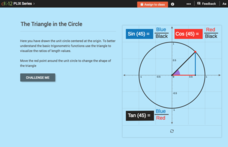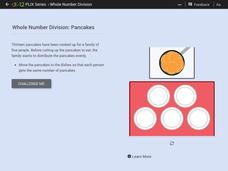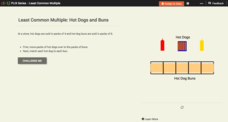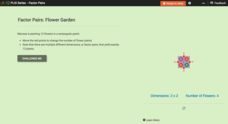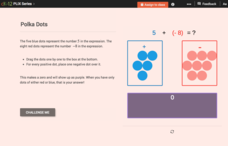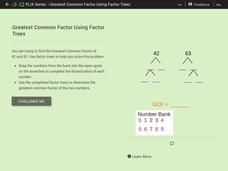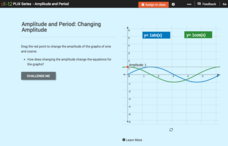CK-12 Foundation
Length of an Arc: Pi Hour
What time is it when the arc length is pi? An interactive displays the measure of the angle created between the hour and minute hand of a clock. Pupils can set the clock to different hours and calculate the arc length based upon the radius.
CK-12 Foundation
Basic Trigonometric Functions: Ladder Length
Climb the ladder to trigonometry. The interactive introduces trigonometric ratios and finding lengths of sides of right triangles created by a ladder and a building. Learners use the interactive to create triangles by moving the top of...
CK-12 Foundation
Sine, Cosine, and Tangent Functions: Lighthouse
How far is that boat from the lighthouse? Scholars create diagrams to represent a scenario given the angle of depreciation from a lighthouse to a boat. Learners apply the basic trigonometric functions to find various distances stemming...
CK-12 Foundation
Secant, Cosecant, and Cotangent Functions: Hold the Ladder!
Determine the length of a falling ladder. Pupils use an interactive to find the angle a ladder makes with the floor after it falls to answer questions. The scholars use the triangle formed in the interactive to determine values of...
CK-12 Foundation
Pythagorean Theorem for Solving Right Triangles: Solving the Triangle
Observe the change in the trigonometric ratios as angles vary. An interactive provides the values of trigonometric ratios for both acute angles in a right triangle. Pupils create a right triangle to match given criteria and find the...
CK-12 Foundation
Angles of Elevation and Depression: Fly-By Calibration
Determine the distance between two trees from afar. Pupils use an interactive resource to create two right triangles using trees and a plane. They determine the horizontal legs of each triangle to find the distance between the two trees.
CK-12 Foundation
Right Triangles, Bearings, and Other Applications: Sailing Race
Help your class get their bearings when it comes to right triangles. Pupils determine distances traveled or components given the bearing of a sailboat using an interactive. The scholars develop a sense of finding the bearings of a given...
CK-12 Foundation
Quadratic Functions and Their Graphs: Soccer Ball Trajectory
Determine critical points in the flight of a soccer ball. Pupils use an interactive resource to find the vertex and x-intercepts of the graph of the trajectory of a soccer ball after being kicked. Scholars investigate the trajectory...
CK-12 Foundation
Comparing Methods for Solving Quadratics: Comparing Methods to Solve a Quadratic
Determine the quickest process for solving quadratics. Pupils compare the number of steps in the process of solving quadratics using three different methods. Scholars determine which situations lend themselves to the different solving...
CK-12 Foundation
Angles of Rotation in Standards Positions: Clock Angles
Use a clock face to develop angles representing standard position angles. The interactive allows pupils to create angles using the hands of a clock. Scholars discover that there is a difference in the angle formed using a clock face and...
CK-12 Foundation
Using Quadratic Equations to Solve Problems: Pizza Slice!
Get the most out of a pizza. Class members use an interactive to simulate cutting a pizza to determine the maximum number of slices possible. The pupils create a set of data points and determine the equation that models the relationship.
CK-12 Foundation
Trigonometric Functions and Angles of Rotation: The Triangle in the Circle
Go around the unit circle and create triangles. Pupils move a point around the unit circles to visualize the triangle associated with the angle in standard position. The three main trigonometric functions are defined in terms of the legs...
CK-12 Foundation
Reference Angles and Angles in the Unit Circle: Exploring Reference Angles
A steal of a deal — get four angles for the value of one. An interactive resource allows individuals to visualize all four angles that have the same reference angle. Pupils answer questions by using the interactive to create the...
CK-12 Foundation
Translating Sine and Cosine Functions: Translating Sine
Learn how to slide sine back and forth and up and down. Pupils move the starting point of a graph of sine vertically and horizontally. They investigate the changes to the equation of the graph in relationship to the translation. They...
CK-12 Foundation
Common Multiples: Sports Calendar
Using a calendar, basketballs, and tennis balls, young mathematicians determine the common multiples of four and six. Individuals drag and drop the balls onto the correct dates each sport will be played, allowing them to see which days...
CK-12 Foundation
Whole Number Division: Pancakes
Given 13 pancakes and five plates, learners are asked to distribute the pancakes evenly among the plates. Is it possible? Will there be any remainders? These are the questions pupils are asked to answer after manipulating an interactive...
CK-12 Foundation
Least Common Multiple: Hot Dogs and Buns
Find the least common multiple of hotdog packages and bun packages in an interactive that allows pupils to drag and drop a set of four hot dogs into a pack of six buns to find the least common multiple of the sets.
CK-12 Foundation
Factor Pairs: Flower Garden
Arrange the dimensions of Marissa's rectangular flower garden so that 12 flowers can be grown. How many factor pairs does the number 12 have? What dimensions are necessary for a square shaped planter?
CK-12 Foundation
Greatest Common Factor Using Lists
By creating a list of factors for two numbers, it is easier to see the greatest common factor. Each question in an interactive resource asks pupils to identify the greatest common factor for the numbers 24 and 36 in several different...
CK-12 Foundation
Whole Number Multiplication: Multiplication Map
How many miles did a car travel if it traveled at 55mph for three hours? What are the factors for this multiplication sentence? These are the questions young mathematicians must solve using a multiplication map.
CK-12 Foundation
Addition of Integers: Polka Dots
What happens when you add negative and positive integers to one another? Do you add or subtract, and will the answer be positive or negative? Young mathematicians use blue and red polka dots to determine the value of an expression that...
CK-12 Foundation
Fraction Ordering with Lowest Common Denominators: Test Your Strength
Young mathematicians use a bell and hammer to see how high or low the puck goes. Then, they order the fractional values to demonstrate the greatest to lowest hit. Students then respond to several questions that require them to use...
CK-12 Foundation
Greatest Common Factor Using Factor Trees
Beginning with a description that sets the stage, learners are asked to break down the numbers 42 and 63 to find the greatest common denominator using factor trees. As they work through the factoring process, young mathematicians are...
CK-12 Foundation
Sine Graph and Cosine Graph: Changing Amplitude
Scholars manipulate the amplitude of the graphs of sine and cosine, notice how the change in amplitude is reflected in their graphs, and answer several questions about the concept they noticed.
Other popular searches
- Similarities and Differences
- Anatomical Similarities
- Cultural Similarities
- Family Cultural Similarities
- Character Similarities
- Animal Families Similarities
- Animal Similarities
- Similarities & Differences
- Comparing Peer Similarities
- Easter Similarities
- "Analogies" Similarities
- Similarities Then




